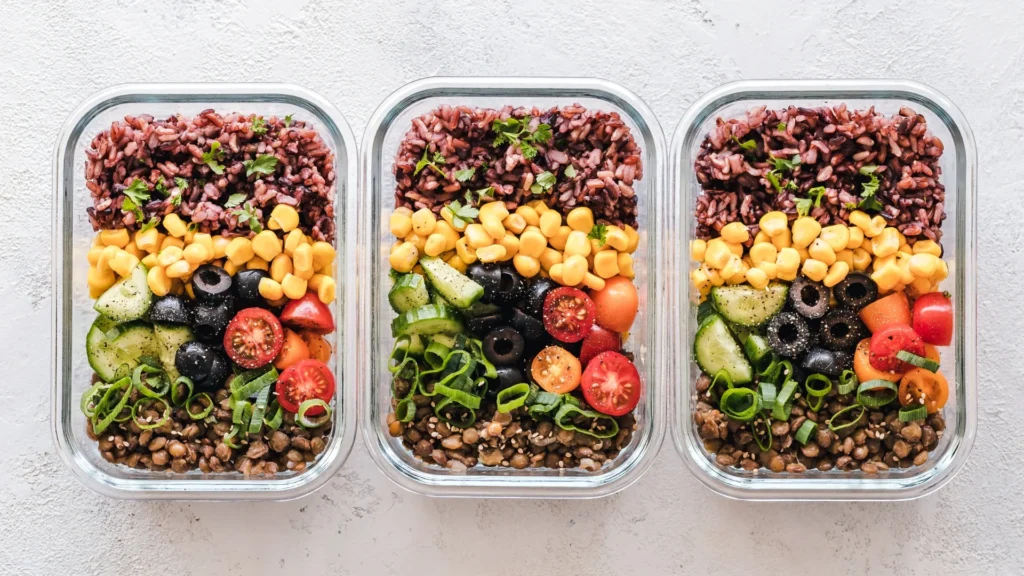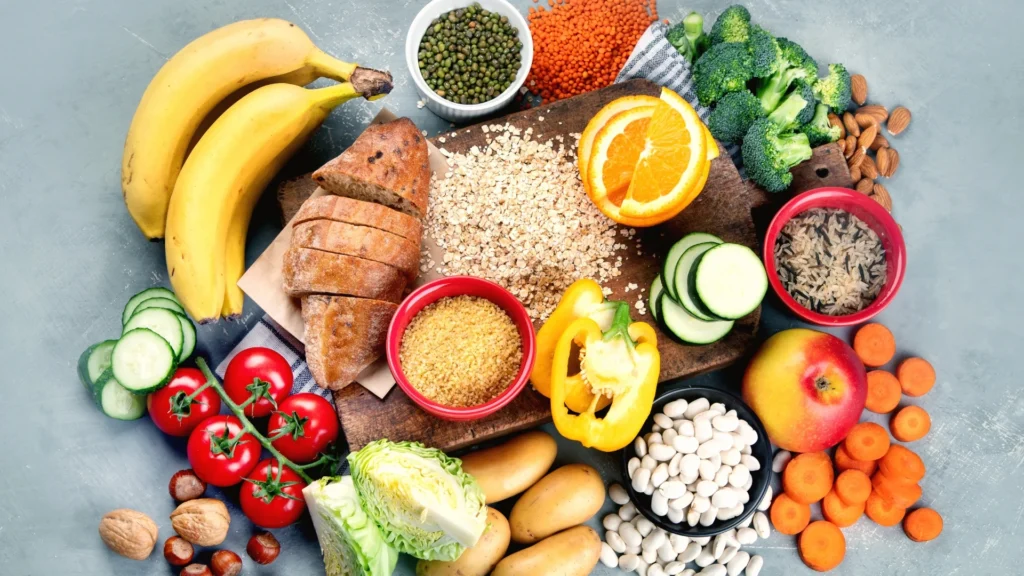Today we will be talking about the Glycaemic Index (GI). What is the Glycaemic Index you may ask? Simply put, it’s a ranking system for carbohydrate foods based on how quickly they raise blood glucose levels.
Why does it matter? Because managing your blood glucose levels through diet can significantly impact your overall health.
This article will take you on a journey to understand the intricacies of the Glycaemic Index, its influence on your body’s response to carbohydrate-rich foods, and the health implications of high and low GI diets. We will not stop there. We will also delve into the factors that dictate the GI values of foods and provide you with practical tips for incorporating GI into your meal planning effectively.
This is not just about blood glucose and carbohydrate food. It’s about gaining control over your health through informed dietary choices. So, get ready to dive deep into the world of Glycaemic Index!
Understanding the Glycaemic Index (GI)

When we talk about how our bodies process foods, especially carbohydrates, the Glycaemic Index (GI) is an important concept. The GI is a ranking system from 1 to 100 that shows how quickly carbohydrates in a food raise glucose levels in the blood after eating. Foods with higher GI values tend to break down quickly during digestion and release glucose into the bloodstream at a faster rate.
How GI Values are Determined
The process of calculating the GI value of foods involves:
- Selecting the Test Food: Choosing a portion of food that contains a specific amount of carbohydrate, usually 50 grams.
- Establishing the Control: Comparing the effects of this test food to a control food – usually pure glucose or white bread, which are given GI values of 100.
- Measuring Blood Sugar Responses: After fasting overnight, people eat the test food and their blood glucose levels are measured at regular intervals over two hours. The GI value is calculated by plotting these readings on a graph and comparing them to the response caused by the control food.
Glycaemic Index vs. Glycaemic Load
It’s important to understand the difference between GI and glycemic load (GL):
- Glycaemic Index (GI): This focuses only on how quickly a food’s carbohydrates increase blood sugar levels.
- Glycaemic Load (GL): This takes into account both the speed of this increase and the portion size, giving a more complete view of how food affects blood sugar over time.
Why GI Matters
The importance of GI lies in its ability to:
- Help people manage their blood sugar levels effectively.
- Aid in making informed dietary choices for those with diabetes or insulin resistance.
Practical Considerations
In everyday situations:
- Understanding that not all carbohydrate-containing foods have the same effect on blood sugar can lead to better food choices.
- Taking into account both GI and GL provides a more detailed approach to planning meals for people who are conscious of their health.
By measuring how different foods affect the speed of glucose increase in our bodies, the Glycaemic Index acts as a useful tool for anyone looking to manage their diet with accuracy.
Health Implications of High GI Foods

Blood glucose levels can be significantly influenced by the foods we eat, particularly those with a high Glycaemic Index (GI). This section will delve into some of the health risks associated with consuming high-GI foods.
High GI Foods and Type 2 Diabetes
Consuming high-GI foods may increase the risk of developing Type 2 diabetes. These foods lead to rapid spikes in blood sugar levels, causing the body to produce more insulin. Over time, this can lead to insulin resistance – a key factor in the development of Type 2 diabetes1.
Impact on Heart Disease Risk Factors
High-GI diets may also influence factors linked to heart disease. Eating foods that rapidly increase blood sugar can trigger inflammation2, a known contributor to heart disease. Additionally, such diets may negatively affect cholesterol levels and elevate blood pressure, both of which are risk factors for heart disease3.
Relationship with Weight Gain and Obesity
Can high-GI foods contribute to weight gain? Yes, they can. When you eat a food with a high GI, your blood sugar rises quickly and then falls just as fast. This sudden drop can leave you feeling hungry again soon after eating, increasing the likelihood of overeating4. As a result, regular consumption of high-GI foods could potentially contribute to weight gain and obesity.
Possible Link with Colorectal Cancer
Some research suggests there may be an association between a high-GI diet and colorectal cancer5. However, it’s important to note that more studies are needed before we can establish a conclusive link.
In summary, while high-GI foods can be part of your diet, being mindful of their potential health implications is crucial. The next section will explore the benefits of including low GI foods in your meals.
Benefits of Including Low GI Foods

When it comes to managing diabetes, incorporating low GI foods into meals is a game-changer for blood glucose control. These foods are digested and absorbed at a slower pace, leading to a more gradual rise in blood sugar levels. This steadiness helps individuals with diabetes avoid the sharp spikes in glucose that can occur after eating high GI foods.
1. Blood Glucose Control
By choosing low GI foods, which have a GI value of 55 or less, people with diabetes can experience fewer fluctuations in their blood glucose levels. This is crucial for long-term management of the condition and helps prevent complications associated with high blood glucose.
The effects of a low GI diet extend beyond just blood sugar stability; it also influences weight management. Weight loss in diabetes patients can be particularly challenging given the metabolic disturbances associated with the disease. However, a low GI diet has been shown to support weight loss efforts effectively.
2. Weight Management
Foods with a lower glycaemic index may promote a feeling of fullness for longer periods and reduce hunger cues, which can help with reducing caloric intake.
3. Fat Storage Prevention
Additionally, since insulin plays a role in fat storage, the lower insulin response elicited by low GI foods may assist in preventing weight gain by minimizing fat storage.
Including low GI options like lentils, non-starchy vegetables, and certain whole grains can make meal planning both nutritious and satisfying while supporting overall health goals for those managing diabetes.
Factors Influencing Glycaemic Index Values

When it comes to managing blood glucose through diet, the Glycaemic Index (GI) is a valuable tool. However, GI values are not static and can be affected by a variety of factors. Understanding these influences is crucial for interpreting GI numbers effectively and making informed dietary choices.
Portion Sizes
Portion size plays a pivotal role in meal planning. The larger the serving, the more carbohydrates it contains, potentially leading to a greater impact on blood glucose levels. It’s essential to balance portion sizes with GI to ensure a comprehensive approach to maintaining stable blood sugar.
Accompaniments and Preparation Methods
The GI of a food can change depending on what it’s paired with or how it’s prepared. For example:
- A bowl of white rice (high GI) can have a moderated effect on blood sugar when eaten with fiber-rich vegetables and lean protein.
- Al dente pasta tends to have a lower GI compared to overcooked pasta, emphasizing how preparation affects glycemic response.
Cooking Time, Processing Techniques
The length of cooking time can alter the structure of carbohydrates. Longer cooking times often break down starches, raising the GI. Similarly, processed foods typically have higher GI values due to the breakdown of complex carbohydrates into simpler sugars during manufacturing.
Fruit Ripeness and Varietal Differences
Take fruit as another example; a ripe banana will have a higher GI than one that’s slightly green. Varietal differences also come into play – for instance, different types of potatoes can vary significantly in their GI values.
By considering these factors alongside the Glycaemic Index, individuals can plan meals that support their health goals more effectively. Moving forward, an awareness of how these elements interact provides a nuanced understanding of how our bodies respond to various foods.
Practical Tips for Applying Glycaemic Index in Everyday Eating

When choosing what to eat, it’s important to consider the Glycaemic Index (GI) along with other nutritional factors. While GI numbers are helpful, they’re not the only thing that matters. Here are some practical tips for using GI in your everyday meals:
1. Focus on Balanced Meals
To keep your blood sugar steady, try to include a mix of low GI carbohydrates, proteins, and healthy fats in each meal. This combination of nutrients works together to provide sustained energy and prevent sudden spikes in blood sugar.
2. Opt for Whole Foods
Whenever possible, choose whole foods over processed ones. Whole grains, fresh fruits and vegetables are generally lower on the GI scale compared to their refined counterparts. Plus, they contain more fiber which helps slow down the absorption of glucose into your bloodstream.
3. Flavor with Herbs and Spices
If you’re watching your sodium intake, you can still add flavor to your meals without relying on salt. Experiment with different herbs and spices like cinnamon, turmeric, or garlic powder to enhance the taste of your dishes. Not only do they make food more interesting, but some spices may also have health benefits of their own.
Tip: Try sprinkling cinnamon on your oatmeal or adding smoked paprika to roasted vegetables for a burst of flavor.
By following these tips, you can create meals that are not only gentle on your blood sugar but also packed with essential nutrients for overall health.
Current Research and Controversies Surrounding Glycaemic Index
In the search for optimal dietary practices, researchers have conducted numerous studies on the impact of Glycaemic Index (GI) and diet, generating critical findings. A noteworthy study in this domain involved a comparison of a low-glycemic load diet and a low-fat diet on weight loss in obese individuals6. This randomized controlled trial revealed the low-glycemic load diet to be more effective in promoting weight loss, influencing the dietary recommendations for obese individuals.
Key Finding: Low-glycemic load diet outperformed low-fat diet in promoting weight loss among obese individuals.
Simultaneously, scientific literature paints a multifaceted picture regarding dietary glycemic load’s relationship with colorectal cancer risk. An examination of the Women’s Health Study7 suggested an association between high dietary glycemic load and increased colorectal cancer risk. However, other research findings remain inconclusive, indicating a need for further investigation.
Shifting gears to another crucial aspect – carbohydrate quality. It is essential to note that it might not be sufficient to consider GI alone for health outcomes. Ongoing debates suggest that looking at overall carbohydrate quality, including both GI and fiber content, could prove more beneficial for health management.
In essence, these aspects underscore the complexity surrounding Glycaemic Index and its role in our diets. As we continue to examine this topic, it becomes apparent that while GI is an important tool, it should be considered as part of a broader nutritional context for achieving optimal health results.
Reliable Sources for Glycaemic Index Information
When looking for reliable information on Glycaemic Index (GI), it’s important to refer to credible sources. Here are some trustworthy sources you can rely on:
1. Harvard T.H. Chan School of Public Health’s website
The Harvard T.H. Chan School of Public Health’s website is a great resource for finding evidence-based information on GI and its effects on health. They provide in-depth articles and research studies that can help you understand the science behind GI.
2. Reputable nutrition databases
There are several reputable nutrition databases available online that offer detailed information on the GI of various foods. These databases compile data from scientific studies and provide comprehensive nutritional profiles. Some popular nutrition databases include:
These platforms allow you to search for specific foods and find their GI values. They can be useful tools in making informed food choices based on their impact on blood sugar levels.
3. Food Labels
While food labels may not always directly list the GI values of products, they can still provide valuable information. When reading food labels, keep the following tips in mind:
- Look for Fiber Content: Foods that are high in fiber tend to have a lower GI. Aim for foods that contain at least 3 grams of fiber per serving.
- Compare Similar Products: If you’re trying to choose between similar food items, compare their nutritional information on the label. Foods with lower amounts of sugar and higher amounts of fiber are likely to have a lower GI.
It’s important to note that GI values can vary depending on factors such as cooking methods and food combinations. These sources are most effective when used together to get a comprehensive understanding of how different foods may affect your blood sugar levels.
Incorporating Glycaemic Index Principles into Your Healthy Lifestyle

Embrace the Glycaemic Index (GI) by integrating it into daily meals and snacks with ease. The goal is to balance enjoyment with nutrition, ensuring each choice supports a healthy lifestyle. Here are some actionable steps:
Breakfast
Start the day with rolled oats topped with fresh berries and a dollop of Greek yogurt, providing a low GI option that’s both filling and energizing.
Lunch
Opt for a quinoa salad mixed with an array of colorful vegetables, chickpeas, and a lemon-tahini dressing, combining varied textures and flavors for a satisfying midday meal.
Dinner
Enjoy grilled chicken or tofu alongside sweet potatoes and steamed broccoli, perfect for an evening meal that’s both comforting and GI-conscious.
Snacks
Choose hummus with carrot sticks or an apple with almond butter; these pairings offer fiber, protein, and healthy fats, contributing to fullness without a significant spike in blood sugar.
Remembering the principles of My Healthy Plate or similar dietary guidelines ensures that GI is just one aspect of the broader picture of health. It’s about making informed choices that align with personal preferences and nutritional needs. This approach paves the way for sustainable habits, forming the cornerstone of well-being.
Conclusion
Exploring the Glycaemic Index (GI) opens up a new dimension in understanding how foods impact blood glucose levels and overall health. Adopting low GI foods might just be the change you need to stabilize blood sugar and enhance your well-being. Remember, a rainbow of foods on your plate ensures a spectrum of nutrients, so consider GI as one hue in the vibrant palette that is your diet.
Harnessing the power of the Glycaemic Index can lead to making more informed decisions at mealtimes. It’s about striking a balance where GI complements other dietary considerations within the framework of My Healthy Plate guidelines.
Should you find this dive into Glycaemic Index insightful, think about those in your circle who could also stand to benefit. Sharing knowledge is pivotal in fostering a community dedicated to healthier lifestyles. For those navigating diabetes or simply aiming to refine their eating habits, our platform extends a wealth of resources tailored to these very journeys.
Read Next: Why Sitting is the New Smoking: 7 Compelling Reasons to Stop Now
FAQ
1. What is the Glycaemic Index (GI)?
The Glycaemic Index (GI) is a ranking system for carbohydrate-rich foods based on their potential to raise blood glucose levels. Foods are scored on a scale of 1-100, with glucose or white bread serving as the reference food (assigned a GI of 100).
2. Why is GI important for managing diabetes?
GI can guide people with diabetes in selecting foods that have less impact on their blood sugar levels. Low GI foods cause a slower and more gradual rise in blood glucose levels, which can help manage diabetes symptoms.
3. Are all low GI foods healthy?
Not necessarily. While low GI foods tend to be healthier options, it’s also crucial to consider other nutritional factors such as fiber content, presence of healthy fats, and sodium levels.
4. How does cooking affect the GI of food?
Cooking time and methods can influence the GI of food. Typically, longer cooking times increase the GI as it breaks down the structure of carbohydrates making them easier to digest.
5. Can I lose weight by following a low GI diet?
While a low GI diet can support weight loss efforts due to its potential effects on appetite regulation and fat storage prevention, it’s essential to pair it with regular physical activity and a balanced nutrient intake for optimal results.
Remember, the Glycaemic Index is one tool you can use alongside others like My Healthy Plate guidelines when planning your meals.
- American Diabetes Association, 60 ↩︎
- Journal of the American Heart Association, 6 ↩︎
- Journal of the American College of Cardiology, 56 ↩︎
- The New England Journal of Medicine, 348 ↩︎
- The Lancet Oncology, 7 ↩︎
- Journal of the American Medical Association, 297 ↩︎
- Journal of the National Cancer Institute, 96 ↩︎



